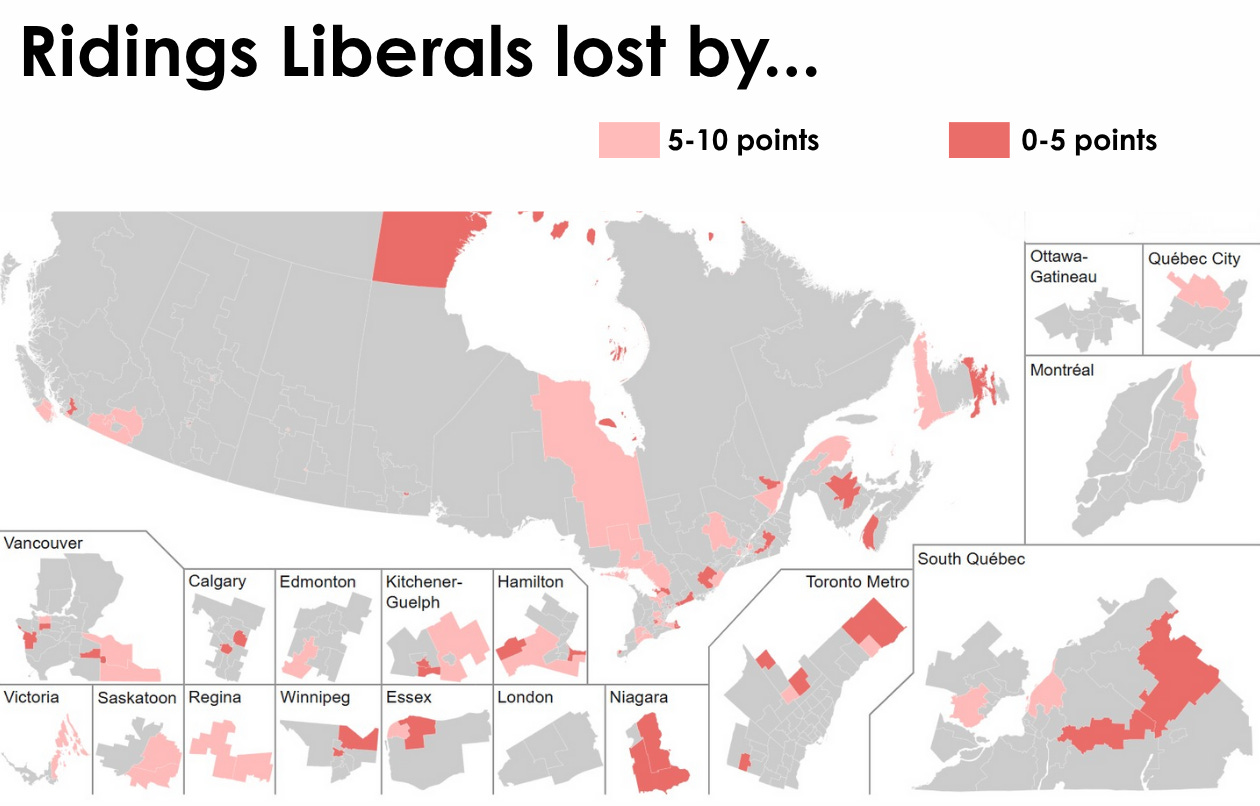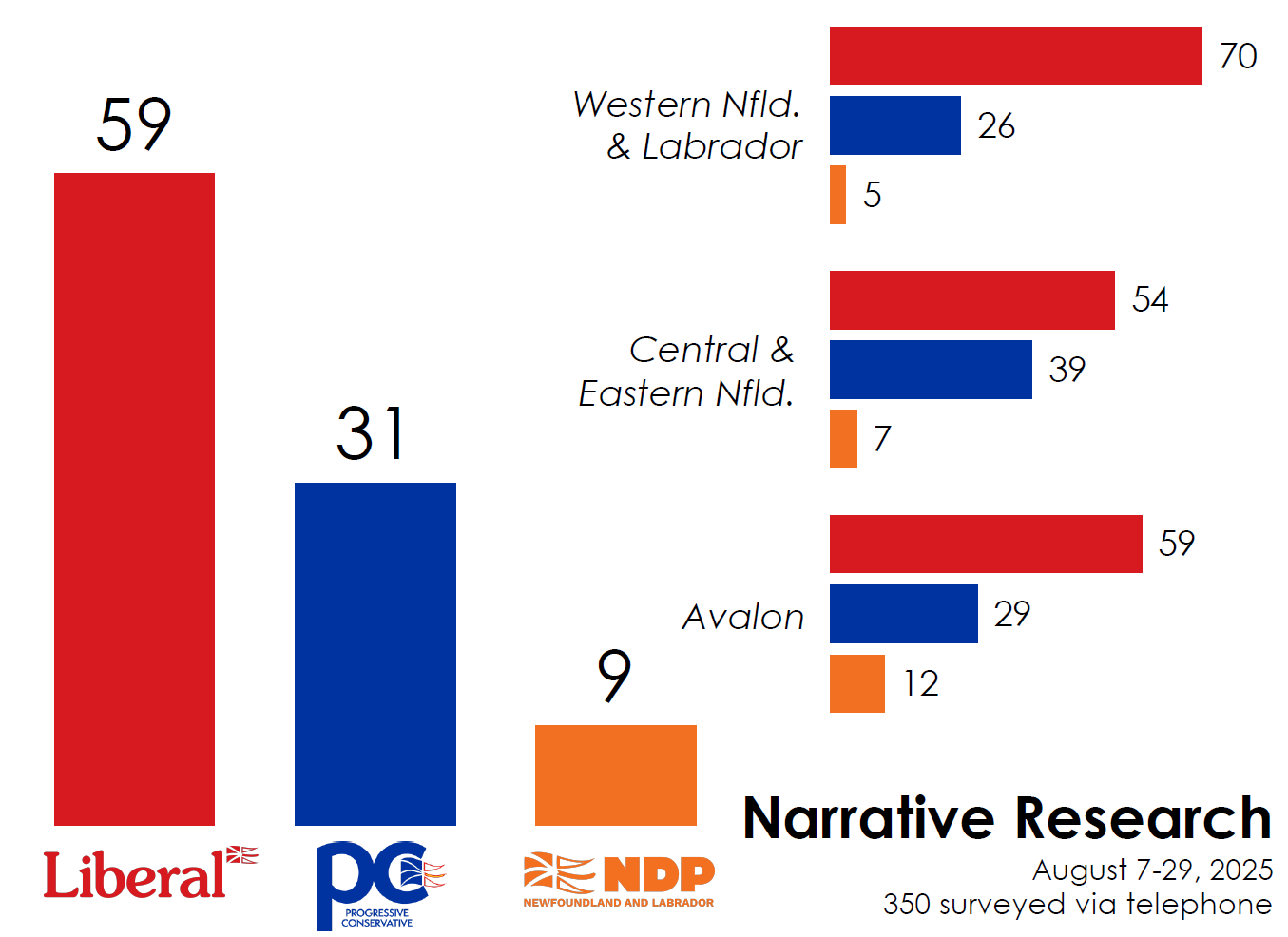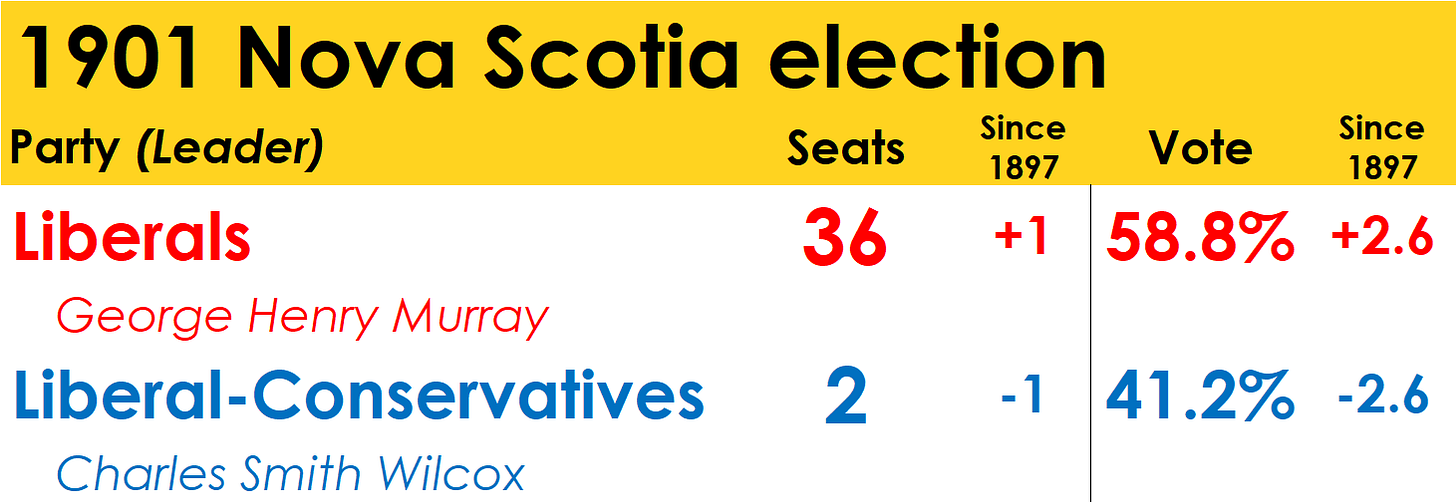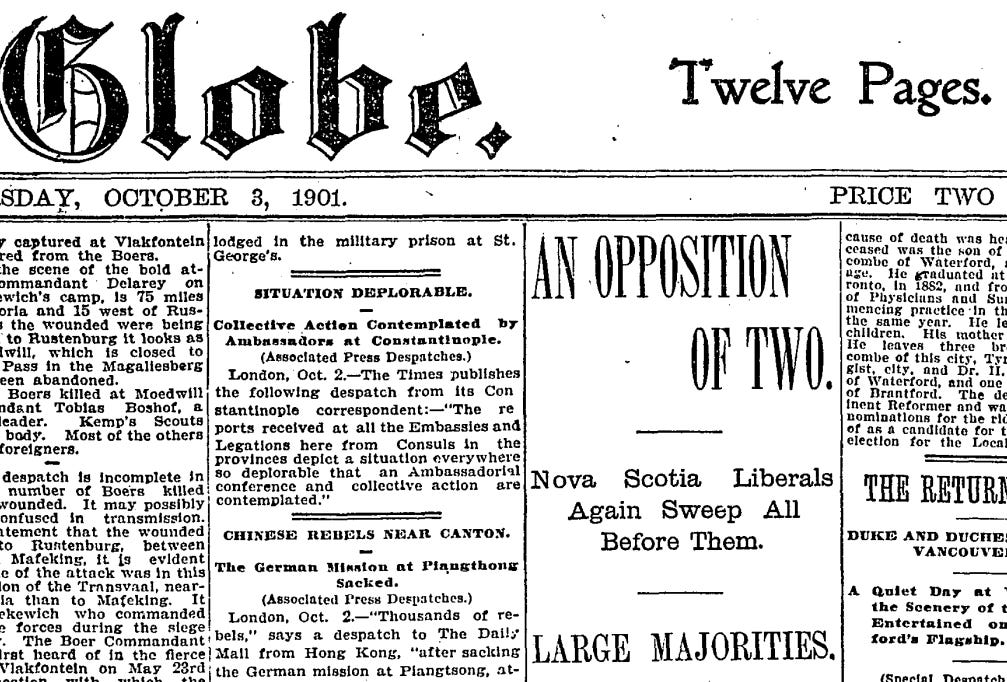Weekly Writ 10/2: Has the Liberal path to a majority changed?
The Liberals made up ground in unexpected places in the last election, potentially giving them more paths to a majority government
Welcome to the Weekly Writ, a round-up of the latest federal and provincial polls, election news and political history that lands in your inbox every Thursday morning.
Over the last decade, the path to a Liberal majority government has been pretty straightforward: dominate the urban centres outside of Alberta and Saskatchewan, win the suburbs in and around Toronto, Montreal and Vancouver, and sweep most of Atlantic Canada.
But did the 2025 election chance that?
The results of that election — as well as the kind of electorate attracted to an unflashy technocrat like Mark Carney — has potentially given the Liberals alternative routes to a majority government. The question is whether they will pursue those alternatives.
The simplest path to a majority would be for the Liberals to hold what they have and target the ridings they narrowly lost in April. The 10 ridings the Liberals lost by less than two percentage points should (in theory) be the easiest ones in which to find the three seats needed to get them to the majority threshold of 172, as well as provide them with a little cushion.
Those seats are Kitchener South–Hespeler and Windsor–Tecumseh–Lakeshore in Ontario, Cloverdale–Langley City, Pitt Meadows–Maple Ridge and Vancouver–Kingsway in British Columbia, Shefford in Quebec, Miramichi–Grand Lake in New Brunswick, Acadie–Annapolis in Nova Scotia, Terra Nova–The Peninsulas in Newfoundland and Labrador, and Nunavut.
There isn’t all that much that unites these 10 seats. They’re a mix of smaller urban centres in Ontario, diverse parts of the B.C. Lower Mainland and ridings in Quebec and Atlantic Canada that are a mix of rural and small towns. A single approach to these seats might not work.
But other types of ridings in which the Liberals have not previously been competitive in have opened up to the party.
According to research done by PoliScience/Pollara, the Liberals did particularly well in the last election among older voters — especially the stereotypical “old white boomer”. PoliScience finds that the Liberals won men over the age of 50 by two points and women over the age of 50 by 18 points. It also found that the Liberals either closed the gap or widened their lead over the Conservatives among only two ethnic groups, as compared to the 2021 election: those of Arabic/North African heritage, and white people.
Knowing that the Liberals made significant inroads among older white Canadians, it should come as no surprise that some of the ridings in which the Liberals made their most gains and came closest to winning included swathes of rural, small town Ontario, parts of Saskatchewan and in B.C.’s Okanagan Valley.
The Liberals came within 10 points (and often much less than that) of winning Barrie–Springwater–Oro-Medonte, Parry Sound–Muskoka, Simcoe–Grey and Simcoe North, ridings that hug Georgian Bay’s cottage country that have typically not been friendly to the Liberals. The party was within six points of winning Lanark–Frontenac and Leeds–Grenville–Thousand Islands–Rideau Lakes in eastern Ontario, the ridings separating Liberal-held Kingston and Ottawa. They were within 10 points of winning Middlesex–London and Elgin–St. Thomas–London South in southwestern Ontario.
The Liberals saw surges of between 26 and 31 points in Saskatoon–University, Saskatoon South and Regina–Lewvan. In addition to Regina–Wascana, these four are ridings the Liberals lost by less than nine points.
In the B.C. Interior, the Liberals gained more than 20 points in Similkameen–South Okanagan–West Kootenay, Vernon–Lake Country–Monashee and Okanagan Lake West–South Kelowna and lost them by less than eight points.
These 15 ridings might be more of a reach for the Liberals as the margins they need to overcome are greater than in some other parts of the country, but they present an alternative route to the party that didn’t exist in the Justin Trudeau era.
This alternative path that goes beyond the one that has worked for the Liberals assumes they can hold what they have. The Liberals can’t take for granted the support they received from racialized voters, an electorate that PoliScience estimates the Liberals won by 13 points. The list of ridings the Liberals won by less than five percentage points includes all five of their seats in Brampton and Burnaby Central, Fleetwood–Port Kells, New Westminster–Burnaby–Maillardville, Richmond East–Steveston and Surrey Centre in the B.C. Lower Mainland.
Mark Carney’s coalition needs to continue to include these voters in order for the Liberals to win. But it’s an interesting dilemma for the Liberals’ strategists to tackle as they consider how best the party could get over the 172-seat threshold. Should they take the path that has worked for them before, even if the Conservatives have made it more difficult, or try the one that has newly opened up to them — and that the Conservatives might be taking for granted?
If the Liberals continue to get a little more older and rural while the Conservatives get younger and more diverse, the electoral map could look quite different after the next election is over.
Now, to what is in this week’s instalment of the Weekly Writ:
News: Heather McPherson and Rob Ashton get into the NDP leadership race, the PEI and Manitoba Liberals choose new leaders, the Greens confirm theirs and voters in St. John’s have to wait another week to choose a mayor. Plus, I clarify and/or correct the record on whether or not Emily Lowan, newly-minted leader of the B.C. Greens, is indeed the youngest party leader ever.
Finally, a new poll is published in Newfoundland and Labrador. Plus, there are new numbers on how Canadians view the temporary foreign worker program and where things stand federally and ahead of the municipal elections in Montreal, Quebec City, Gatineau and Saguenay.
#EveryElectionProject: George Henry Murray scores his second of six victories in the Nova Scotia election of 1901.
Upcoming milestones for Wab Kinew, Danielle Smith and Tim Houston.
The first Weekly Writ of the month is free to all subscribers. If you haven’t already upgraded but like what you see, please upgrade your subscription to get full access to the Weekly Writ every Thursday:
NEWS AND ANALYSIS
ELECTION NEWS BRIEFS
MCPHERSON LAUNCHES - As widely expected (and telegraphed), Edmonton Strathcona MP Heather McPherson launched her bid for the NDP leadership on Sunday. She pitched that the party needs to expand the base and be more inclusive rather than shrink “into some sort of purity test” — a statement that was not appreciated by Winnipeg Centre MP Leah Gazan. Former Alberta premier Rachel Notley was present at McPherson’s launch, making hers the first major endorsement of this leadership contest.
ASHTON ALSO LAUNCHES - Rob Ashton, president of the International Longshore and Warehouse Union, launched his campaign for the NDP leadership on Wednesday. While Avi Lewis is taking the activist progressive wing and McPherson is taking the moderate lane, Ashton is focusing on the labour angle.
MAY LEADERSHIP - Green leader Elizabeth May has survived her leadership review, obtaining 81% support from members. The leadership review went ahead despite the fact that May has announced she won’t lead the party into the next election. May confirmed this in the party’s press release about the results, saying “I am grateful to take my leave on a high note!” A date to replace May has not been set.
MLP LEADER NAMED - Willard Reaves has been named the new leader of the Manitoba Liberal Party after he was the only candidate to qualify for the party’s leadership contest. Reaves is a former Winnipeg Blue Bomber and ran for the Liberals in a 2022 byelection that nearly defeated future PC leader Obby Khan. He ran again in the 2023 provincial election and finished a strong second in Khan’s Fort Whyte riding. The Liberals have only one seat in the legislature.
PEI LIBERALS - The PEI Liberals will choose their new leader on Saturday. The two candidates vying for the position are former MLA Robert Mitchell and businessman Todd Cormier. The Liberals have been leaderless since Sharon Cameron failed to win a seat in the 2023 provincial election, but the party nevertheless currently forms the official opposition in Charlottetown.
ST. JOHN’S ELECTION - Municipal races are taking place across Newfoundland and Labrador today (in the midst of the provincial campaign), but the biggest contest in St. John’s is moving to Wednesday due to the Canada Post strike. Danny Breen, the two-term incumbent, is being challenged by businesswoman Ivy Hanley. Breen, first elected in 2017, ran unopposed in 2021.
YOUNGEST LEADER? - Last week, I said that B.C. Green leader Emily Lowan, 25, might be the youngest leader of a party (with representation in a legislature) in Canadian history. A few sharp readers alerted me to the fact that Mario Dumont, former leader of the Action démocratique du Québec (ADQ), was just 24 when he won a seat in the National Assembly in 1994. His is a bit of a special case, however, as he was one of the founders of the party and became its leader before it won its first seat. When he won that seat, it seems that Dumont likely became the youngest leader of a party with representation. But I think Lowan might be the youngest person to win a leadership race of a party with elected members.
POLLING HIGHLIGHTS
First campaign poll for NL, with an asterisk
Poll, ho!
Our prayers were answered yesterday when we finally got our first published poll of the Newfoundland and Labrador election campaign, which ends in 12 days.
One problem, though: the poll was conducted in August.
Narrative Research published the voting intentions and best premier results of its quarterly poll of Newfoundland and Labrador yesterday, two weeks after they initially reported the government satisfaction results of the survey. While I’m glad to see that Narrative has decided to publish these results, it is worth emphasising that this poll was in the field between August 7 and 29, and so some of the data collection is now nearly two months old. The survey also interviewed just 350 residents, 253 of whom were not undecided. This means the poll’s voting intentions results come with a margin of error of roughly +/ - 6 points.
With those significant caveats in mind, let’s take a look at the results.
Heading into the election call, John Hogan’s Liberals led with 59% support according to this poll, followed by Tony Wakeham’s PCs at 31% and the NDP under Jim Dinn at 9%.
The Liberals held wide leads throughout the province, though their edge was especially pronounced in Labrador and Western Newfoundland and on the Avalon Peninsula. The PCs were strongest in Central and Eastern Newfoundland, while the New Democrats had their best showing in Avalon. The Liberals led among all age groups and genders, but had a bigger advantage among women and older voters.
That regional and demographic pattern of support is what one might expect, considering what four byelections hinted at in 2024 and what the federal results pointed to earlier this year. The size of the Liberals’ lead throughout the province, however, is perhaps a bit more expected. But it is important to note that wildfires were hitting the province in August and the premier was in the news on a daily basis as his government tried to tackle them.
Hogan seems to have entered the present campaign with a significant leadership advantage. He was the choice for premier of 50% of respondents, giving him a 28-point lead over Wakeham, the same lead his Liberals enjoyed over the PCs. This advantage was corroborated by the recent Angus Reid Institute poll, which was done at roughly the same time and gave Hogan higher approval ratings than Wakeham.
In Monday’s edition of the Election Writ, I’ll put these numbers through a seat projection model (as well as any other numbers that might emerge before then). But this would clearly deliver the Liberals a big majority government.
It’s possible that this campaign has not shifted the dial all that much and the results on election day will be similar to these from Narrative. Hopefully we’ll soon have a poll published that has been conducted during the campaign to give us a better clue of what to expect — otherwise voters might cast a ballot with an out-of-date impression of where this race stands.
POLLING NEWS BRIEFS
NANOS POLL - The latest iteration of the four-week rolling poll from Nanos Research gives the Liberals 41% support against 37% for the Conservatives. This brings Nanos into the range we’ve been seeing from other pollsters for the last few weeks. The NDP trails in third with 12%. Mark Carney is the preferred prime minister of 50% of respondents compared to 29% for Pierre Poilievre. Notably, Donald Trump and U.S. relations has fallen 10 points over the last four weeks as a top (unprompted) issue for Canadians.
TFW PROGRAM - A majority of Canadians believe the temporary foreign worker program is bad for the labour market for Canadian citizens, bad for younger workers and bad for the housing situation, according to a new poll from the Angus Reid Institute. A majority believe the program is beneficial to the businesses who employ those workers, but also that they are treated unfairly by these employers.
QUEBEC MUNICIPAL RACES - While nearly half of Montrealers say they are undecided ahead of their municipal election, former Liberal MP Soraya Martinez Ferrada of Ensemble Montréal is leading among those who have made up their minds in a new poll by Léger. Before the removal of undecideds, she has 20% support. Luc Rabouin, the successor to Valérie Plante as the mayoral candidate of Projet Montréal, trails with 11%. Voters in Quebec City are less uncertain, with only a little more than a quarter of voters undecided. Incumbent Bruno Marchand leads with 27%, followed by former Liberal MNA Sam Hamad with 20%. In Saguenay, the incumbent Julie Dufour has just 5% support, while Andrée Laforest, who just resigned from the CAQ government to run for the mayoralty, leads with 47%, according to a new Segma poll. Finally, in Gatineau the incumbent Maude Marquis-Bissonette leads Mario Aubé, 58% to 36%, in another Segma survey.
12-MONTH ELECTORAL CALENDAR
October 2: Municipal elections in Newfoundland and Labrador
October 4: P.E.I. Liberal leadership
Candidates: Todd Cormier, Robert Mitchell
October 6: New Brunswick provincial byelection in Miramichi West
October 8: Municipal election in St. John’s
October 14: Newfoundland and Labrador provincial election
October 20: Municipal elections in Alberta
October 27: Nunavut territorial election
November 2: Municipal elections in Quebec
November 3: Yukon territorial election
November 9: Québec Solidaire co-leadership
Candidates: Yv Bonnier-Viger, Étienne Grandmont, Sol Zanetti
March 29: Federal NDP leadership
May 11: Municipal elections in New Brunswick
Byelections yet to be scheduled
QC - Chicoutimi (to be called by March)
Party leadership dates yet to be set
P.E.I. PCs (Dennis King resigned on February 20, 2025)
Federal Greens (Elizabeth May announced on August 19, 2025)
Ontario Liberals (Bonnie Crombie announced on September 14, 2025)
Future party leadership dates
October 17, 2026: New Brunswick Progressive Conservatives
November 21, 2026: Nova Scotia Liberals
ON THIS DAY in the #EveryElectionProject
An Opposition of Two
October 2, 1901
When George Henry Murray called an election in Nova Scotia for October 2, 1901, he had every right to expect that he’d win again. His Liberals had been in office for nearly 20 years. He himself had won a solid majority victory in 1897, shortly after he replaced W.S. Fielding as premier of the province, by winning 35 of 38 seats.
The Liberals under Wilfrid Laurier had ousted the Conservatives from national office in 1896 and the benefits of the Liberal connection between Halifax and Ottawa were clear. Fielding still held a great degree of sway in Nova Scotia after joining Laurier’s new cabinet, and the friendly atmosphere helped liberate $617,000 from Dominion coffers to finance the construction of new branch railways in the province, money that the former Conservative government had refused to share.
Murray, who would prove to be one of the most electorally successful party leaders in Canadian history, was not a particularly dynamic or skilled politician. But he inherited a strong party organization from Fielding and he kept his government rather clean — at least by the standards of the time. Murray was seen as an honest, friendly and cautious leader who didn’t rock the boat or hesitate to speak to the man in the street.
Against Murray in the 1901 election were the Conservatives (or Liberal-Conservatives, as they were also known) under Charles Smith Wilcox, who unexpectedly found himself leader of the party after the Conservatives were reduced to just three seats in the legislature in 1897. But he grew into the job, emerging as a strident critic of the Liberals on a few key files. When he died in 1909, he was described as “courteous in debate, considerate of the opinions of others and moderate in the presentation of his views.”
Against the juggernaut Liberals, Wilcox and the Conservatives would try their best. At a convention in July ahead of the October election, the Conservatives charged the Liberals “with making use of money, patronage and other corrupting influences to hold themselves in power” and questioned their management of the roads, the railways and the public finances of Nova Scotia. They also got some help from Robert Borden, leader of the national Conservative Party, who participated at the nominating convention in Halifax and campaigned for the Wilcox Conservatives during the election.
The Liberals got some help from Fielding, of course, but they had an easy case to make. It was their party that got the railway money from Ottawa. It was their party that had doubled the government’s revenues since 1882 and had made it possible for Nova Scotia to invest in things like infrastructure and education. Their policies had “been intelligent and progressive, and well adapted to the development of the great resources of the Province”, according to Murray.
The Conservatives tried to make the case for change — a tough sell in a province that would prove to be only halfway through a 43-year span of Liberal government. They reminded Nova Scotians that Murray had argued that no government should be kept in power for too long when he was campaigning against the federal Conservatives in 1896. Surely the same logic should apply to the Liberals’ long stint in office in Nova Scotia.
Voters didn’t buy it. The result was a lopsided victory for Murray’s Liberals. The party captured 36 seats, leaving just two for the Conservatives: one in Pictou and one in Cumberland. The Liberals swept everything else, including Hants where Wilcox went down to defeat.
In trying to explain the landslide Liberal win, the Liberal-friendly Globe ventured “it would appear that the Government had a record which could not be seriously attacked, and that the Opposition, while it presented an elaborate programme to the electors, was unable to concentrate public attention upon any one issue.”
The second of what would be Murray’s six consecutive majority victories did not bring the Liberal leader much happiness. He suffered a nervous breakdown after the election that was described as “gloominess, depression, want of confidence in himself.” He spent most of the next year’s legislative session in the United States for treatment, but he’d be back to his winning ways before long — though he’d never again repeat his feat of limiting his opposition to just two.
MILESTONE WATCH
On Friday, Wab Kinew will surpass Heather Stefanson as the 18th longest serving premier of Manitoba. Kinew defeated Stefanson in the 2023 provincial election.
On Monday, Danielle Smith will mark three years as leader of the United Conservative Party of Alberta. When she took over the UCP and became premier, her party was trailing in the polls behind Rachel Notley’s New Democrats. She managed to turn those numbers around and win the 2023 election. Today, she looks more likely than not to win re-election in 2027 (or earlier).
And on Wednesday, Tim Houston will surpass John Savage as the 13th longest serving premier of Nova Scotia. Savage, a Liberal, governed between 1993 and 1997. His only election win came in 1993, but he resigned before facing the electorate again. His successor, Russell MacLellan, secured the flimsiest of minority governments in 1998.
That’s it for the Weekly Writ this week. The next episode of The Numbers will be dropping on Tuesday. The episode will land in your inbox but you can also find it on Apple Podcasts and other podcasting apps. If you want to get access to bonus and ad-free episodes, become a Patron here!







Do you think the Liberals seemingly having so many new opportunities is a one-off due to the NDP’s collapse (similar to the NDP sweeping Bloc territory in 2011)?